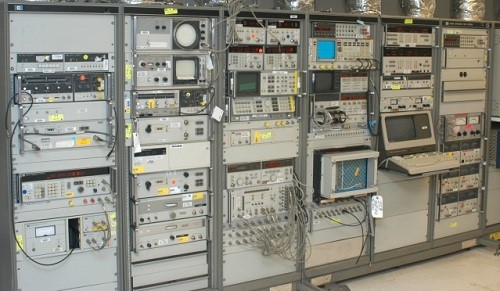I’ll spare the reader yet another glowing review for the Mini1300 analyzer. No I won’t – I’m still going to spew my thoughts on this thing. I picked one up based on the recommendation of a buddy in the two-way business. In his words, “It’s no site-hawk, but it’s pretty good for antenna checks and general use purposes”.
One thing I did learn, on unboxing – the initial calibration / operation sequence has some specific requirements. Like any piece of test equipment, I ran a calibration as soon as I opened the box. No bi deal, right? Well… when I tried scanning an antenna up to 900 MHz, the unit wouldn’t operate past 600 MHz. I couldn’t enter any frequencies past 599 MHz. The software wouldn’t let me change the GHz or hundred MHz digits to any values above 500 MHz. I thought I got a Mini600 in Mini1300 case or something.
On a whim, I ran an “Oscillator Test (Fmax).” The device ran two different oscillator checks. The first one topped out at 600 MHz (or thereabouts). The second check went much higher in frequency – well into the 1300 MHz region.

After the Oscillator test, I went back to the frequency sweep, and I could then run a frequency sweep starting above 600 MHz.
Obviously – after this, I ran a new calibration, to ensure I got proper results.
I will mention a couple other minor operational nits. One, the sturdy metal case is nice enough, but the edges and corners are “sharp” – no, it’s not going to cut you just by touching it, but it can be uncomfortable to hang onto single handed for a while. A rubber or silicone wrap would make it easier to hold on to, and possibly cushion it a bit, if it were to get dropped.
Second, I noticed that the touchscreen mapping can be improved a bit – some of the edge buttons can be tough to activate. A touchscreen stylus makes that easier.
For the frequency sweep operation, the only option is to set a start frequency and span. I would much prefer the option to set a start and stop frequency manually, so I could scan, for example, 803 – 870 MHz. I’m stuck entering 800 MHz, and scanning a 100 MHz span. A minor inconvenience.
Regarding the user interface for the frequency sweep, there’s some unique items that differ from more expensive commercial test equipment. The cursors, on a frequency sweep, must be controlled through the use of a button – they cannot be dragged and oved with a finger – while that would be nicer from the user interface standpoint, I also realize there are limits to both the hardware and development efforts. Additionally, while the scan is running – the device draws a flat line on the screen as it progresses through the frequencies. This can be distracting, because it looks as if the device is measuring a flat response – until it finishes the scan and updates the screen. That’s just something that the user needs to be aware of.
So I guess I did make this a mini-review. Other than those minor issues, it’s fairly simple to use, and packs in a lot of features.
I don’t think it was ever intended to duplicate a piece of commercial test equipment – it wasn’t designed in that manner, or by people who make a living in that market.
The cost for the functionality is a real key point! I think I paid $300 for my ‘259 back in the early 2000’s – it was awesome to not need a SWR meter, and the potential of damaging a radio when checking things out. We used it on numerous occasions when I was in W0EEE to test out strange antenna ideas (chain link fences, shopping carts, what have you). I paid about the same (used) for the DG8SQ VNWA maybe 5 or 6 years ago. The mini1300 is $160 (Amazon.com).
Let’s face it – technology has come a long way with SDRs and DSPs since the 90’s when the MFJ-259s were the hot item to have. I had an MFJ-259, and got a lot of use out of it – it was a lot more convenient than SWR meters and worrying about transceiver damage during antenna tuning. Maybe 6 years ago, I got a DG8SQ VNWA-3. It was a great little device – I could scan an entire band (or more) in a pinch, as long as I had a PC along. This made tuning wideband antennas a cinch, since it could be done graphically… and cavities? those are cake. I did a writeup on this when I borrowed a VNWA-3 from N0AX: https://www.kc9umr.com/?p=68. I’ve set the laptop up in the cab of my truck while I tuned antennas – it’s not ideal, but it was workable. The 1300, with display and all components in one box, is much more portable. For bench testing filters or components, the VNWA-3 might be a little more accurate – or at least a little more convenient to configure, so it does have some benefits, since it’s connected to my bench PC anyway.
Anyone want to buy an MFJ-259?
